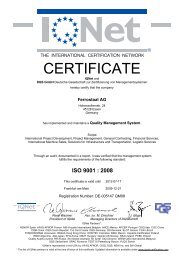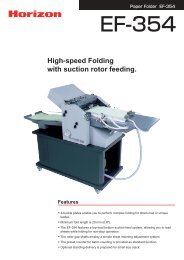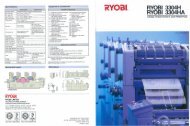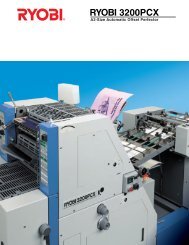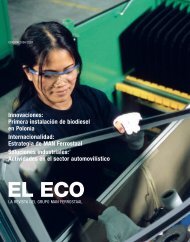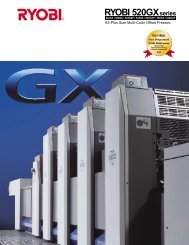THE ECHO - Ferrostaal
THE ECHO - Ferrostaal
THE ECHO - Ferrostaal
Create successful ePaper yourself
Turn your PDF publications into a flip-book with our unique Google optimized e-Paper software.
30 <strong>THE</strong> <strong>ECHO</strong> August 2007<br />
31<br />
ProjECtS<br />
Products and Markets<br />
Distillation columns of a methanol plant<br />
The demand for fertilisers is developing disproportionately<br />
to the growth in population. The faster the population<br />
grows (currently approximately 1% per year), the greater the<br />
demand for food and the more that has to be grown. On top<br />
of this, there is the increasing prosperity that, in many<br />
countries, leads to an increased consumption of meat and<br />
so to more intensive cultivation of feed crops. The rule of<br />
thumb here is that the consumption of meat takes ten times<br />
as many plants for feeding the animals as the consumption<br />
of a vegetarian diet. Both these developments taken together<br />
result in a sharp rise in the demand for fertilisers. In many<br />
countries, the effect of state support for the production of<br />
biofuels such as biodiesel and bioethanol is also an increase<br />
in demand in the fertiliser market.<br />
UAN currently has a share of about 15% of the market for nitrogen<br />
fertilisers. The reason why the share is still relatively<br />
small is that UAN is a liquid and, in most cases, can therefore<br />
only be applied where irrigation systems already exist.<br />
Urea, on the other hand, an intermediate product of the<br />
plant and also a fertiliser, is a solid and can be applied without<br />
an irrigation system. In the long term, it may be anticipated<br />
that the market share of UAN will grow as the modernisation<br />
of agricultural production processes in emerging<br />
and developing countries increases, for liquid fertilisers can<br />
also be mixed with other substances, such as pesticides,<br />
thus reducing the number of applications required. Climate<br />
change is also leading to an increase in the use of irrigation<br />
systems, as many areas are suffering from reduced rainfall<br />
in the summer.<br />
Over three-quarters of the worldwide production of UAN (16<br />
million tonnes per year) are sold in the USA and France. The<br />
largest buyer is the USA. But the demand from Australia and<br />
Argentina is currently growing very quickly, even if from a<br />
low base level. The largest exporter of UAN is Russia. There,<br />
the gas price has up to now been relatively low, so the manufacture<br />
of UAN is cheap. In the USA itself, the supply can<br />
be expected to fall in the years to come. Some of the production<br />
plants are being closed due to their age, and the construction<br />
of new plants is unlikely because of the high<br />
price of gas. Part of this gap is to be filled by the new plant<br />
in Trinidad.<br />
ProjECtS<br />
Versatile in use<br />
Melamine resins are resistant to UV light, fire, water, impact<br />
and scratches and are therefore suitable for a wide range of<br />
surface finishes. Melamine resins are important for the<br />
wood and furniture industry. In the production of laminate<br />
flooring, for example, the actual floor surface is melamine<br />
resin. It is also frequently used in the wood industry as an<br />
adhesive. Melamine resins also have high electrical resistance,<br />
so they are used as insulating elements in the electrical<br />
industry. The textile industry also makes use of resins to<br />
make textiles resistant to water and creasing. In the automobile<br />
industry, the resistance of melamine to water, scratches<br />
and impacts is valued, especially in the paints sector.<br />
Melamine is used for surface finishing.<br />
The demand for melamine is currently a little over a million<br />
tonnes per year and is rising, on average, at an annual<br />
rate of about six per cent. Against this background, the demand<br />
is expected to double by the year 2020. The plant in<br />
Trinidad is intended to serve both the US American and the<br />
European markets. For the US market, melamine from<br />
Trinidad is attractive because US production plants have<br />
had to be closed because of the high price of natural gas.<br />
The low manufacturing costs in Trinidad also make the<br />
product interesting for the European market. Neither does<br />
the construction of new melamine plants in China (some<br />
on the basis of a licence from Eurotecnica), the United Arab<br />
Emirates or Qatar make much difference here. While the<br />
gas prices are also low there, export from Asia or the Near<br />
East is less attractive because of the high transport costs.





